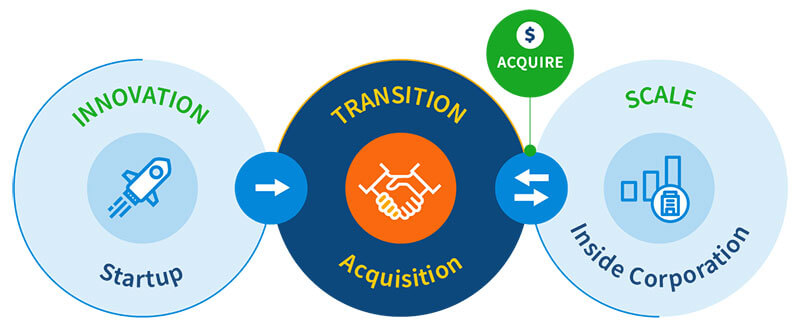Corporations seeking to implement breakthrough strategies for emerging markets need to decide the right way to organize a new venture to enable it to scale.
Here are five strategies companies frequently adopt for scaling disruptive innovations:

1. Spin In
Buy a startup to acquire disruptive technology or new capabilities and scale it up within the organization. This gives rapid access to new capabilities that can fuel growth using the existing brand, manufacturing, and sales channels of a corporate. However, early-stage firms can be high-risk. Corporates may also kill off a business they do not understand. French advertising company Havas learned this lesson when they bought Victors & Spoils, a crowdsource creative agency. The firm’s DNA rejected the innovation, and it closed within five years.
Pro: Riskiest part of the venture happens outside of the organization
Con: Most acquisitions destroy value—it is still risky to scale a business you do not know
2. Spin Out
An alternative is to do all the development of the new business in-house and then spin-out the new venture before the antibodies of the core business can kill it off. Scaling a new venture with disruptive technology or new capabilities externally also gives access to new sources of capital. Technology manufacturer Flex did this successfully with Elementum. This is a cloud-based supply chain platform that Flex built internally and then spun out as a separate business. Flex gets a financial benefit from this transaction, but does it help the business build new capabilities or position itself to defend against disruption? Not really, and that’s a problem when you are in a cut-throat market, looking for differentiation against low-cost competitors.
Pro: Maximum freedom to follow the entrepreneurial path to success
Con: Existing business is unchanged and vulnerable to disruption
3. Build-in Business Unit
Every business needs to innovate to improve its value proposition, optimize processes, cut costs, and adopt new technologies. This is good incremental innovation best done inside existing business units. Is that the right place for more radical, disruptive plays? GE Digital found itself caught between the CEO’s transformative vision to become a leader in predictive analytics and core business units who needed digital capabilities to make today’s offerings better. It had to work with resources from the core business, did not have its own P&L, and was killed off as soon as performance dipped. This is the usual story.
Pro: Organizationally simple
Con: Core business always beats Explore when resources are pressurized
4. Incubation Unit
Startups move at a speed that corporates can only dream about. They can explore new domains, play with alternative business models, and entertain risks that would make most CFOs wince. That’s made incubation units in which corporations grow new entities at arm’s length outside the firm increasingly popular. Stanley Black & Decker have done this successfully with Surehand, a platform for recruiting high-skill blue-collar talent. These corporate ventures are standalones. They do not leverage assets of the core business and so the odds of success are no better than a venture-capital backed startup.
Pro: Autonomy to act, free from corporate restraints
Con: Odds of success no better than a VC-backed startup, don’t leverage core assets
5. New Corporate Venture
Corporate Ventures or Emerging Business Opportunities are a proven way to build new businesses in existing organizations. Championed by IBM in the early 2000s, these units give teams the autonomy to grow like a startup, but with access to the assets of the mothership. Corporate Ventures create new sources of growth and teach the core business capabilities it needs for its long-term transformation. However, you need to know how to stop the venture getting killed by the culture of an existing business. Ambidextrous Organizations are hard to build, but evidence suggests they outperform other approaches.
Pro: Freedom to act without constraints, but using corporate assets to go faster than a startup
Con: Manage access to the core assets so venture is not affected by corporate inertia
 So, which option is best?
So, which option is best?
The answer has to be: ‘it depends’. You need to know what you want to achieve and how much risk the business is willing to take on. Contrary to popular belief, Spin-ins and Spin-outs are the higher risk options. Incubation units and Corporate Ventures promise higher returns.
To decide, ask yourself these questions:
- How important is what you will build to the future of the firm?
- Are there assets in the core business that will help the new venture go faster than a start up?
- Does the innovation represent a new way of doing for the core business?
Change Logic has decades of experience helping firms to resolve these questions. We specialize in setting up Ambidextrous Organizations that balance autonomy for new units with access to the assets of the core business. We help firms to develop new business growth strategies, align a senior team behind that strategy, and set up new corporate venture units.
Learn more about Ambidextrous Organizations and how Change Logic can help you build one.




